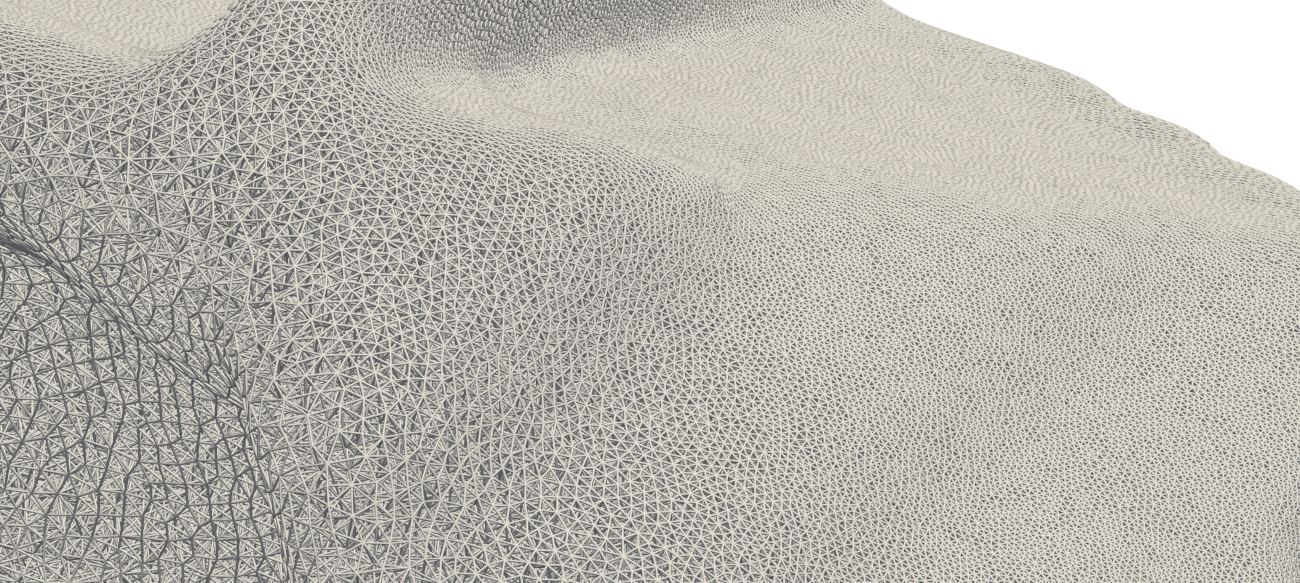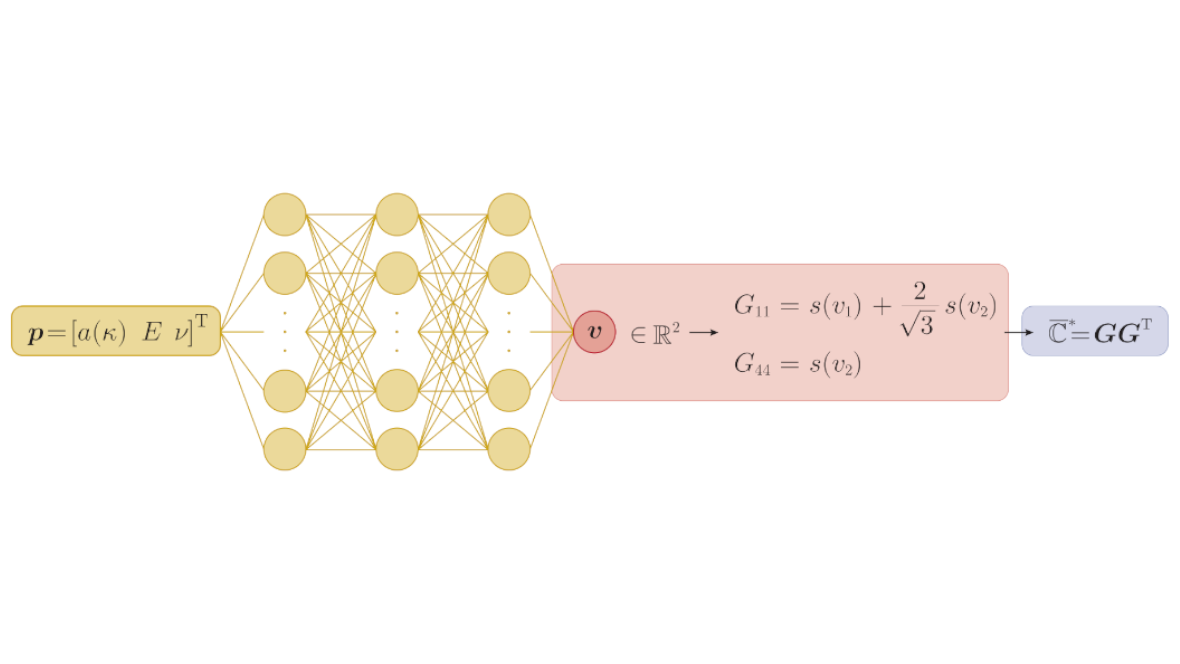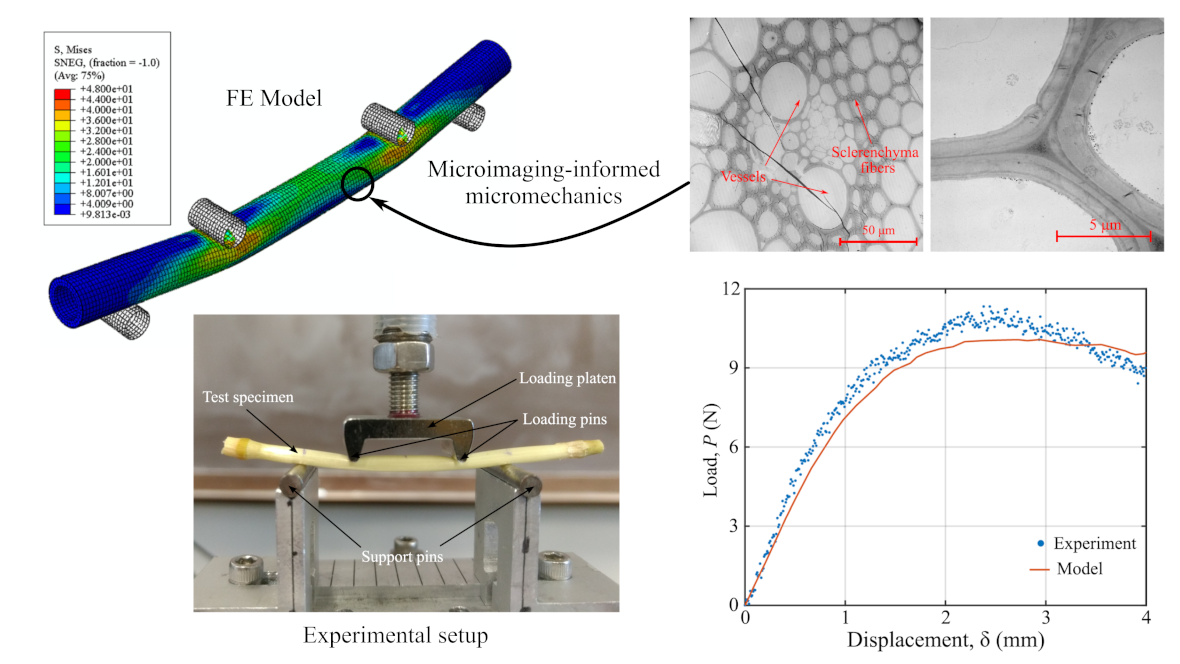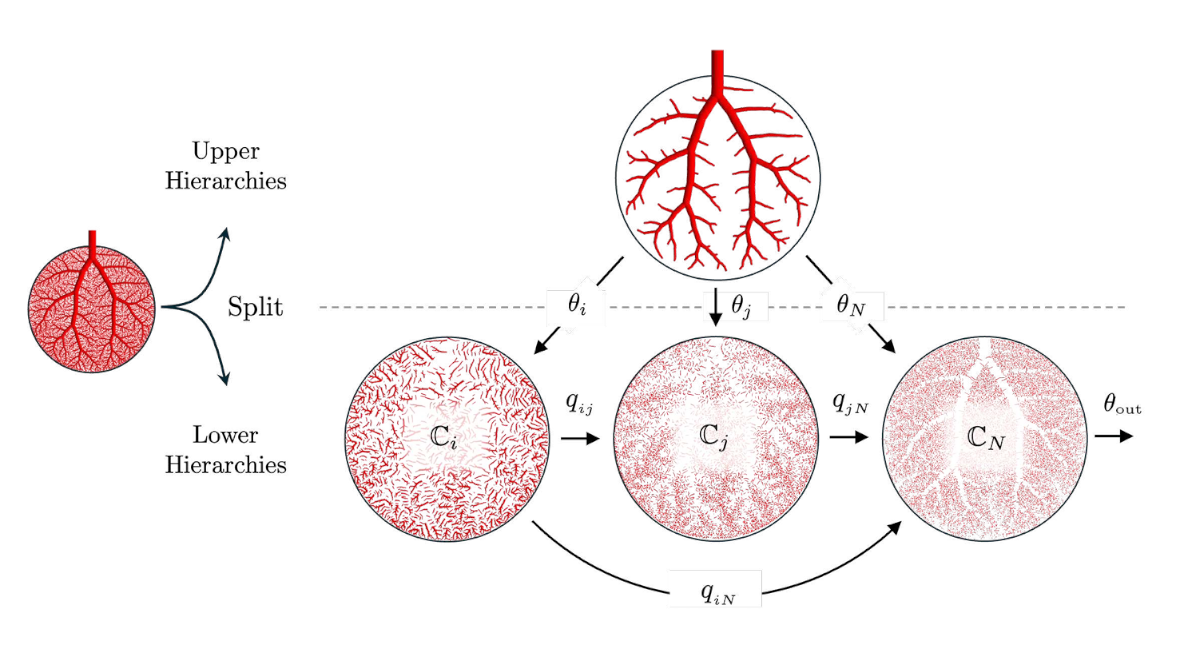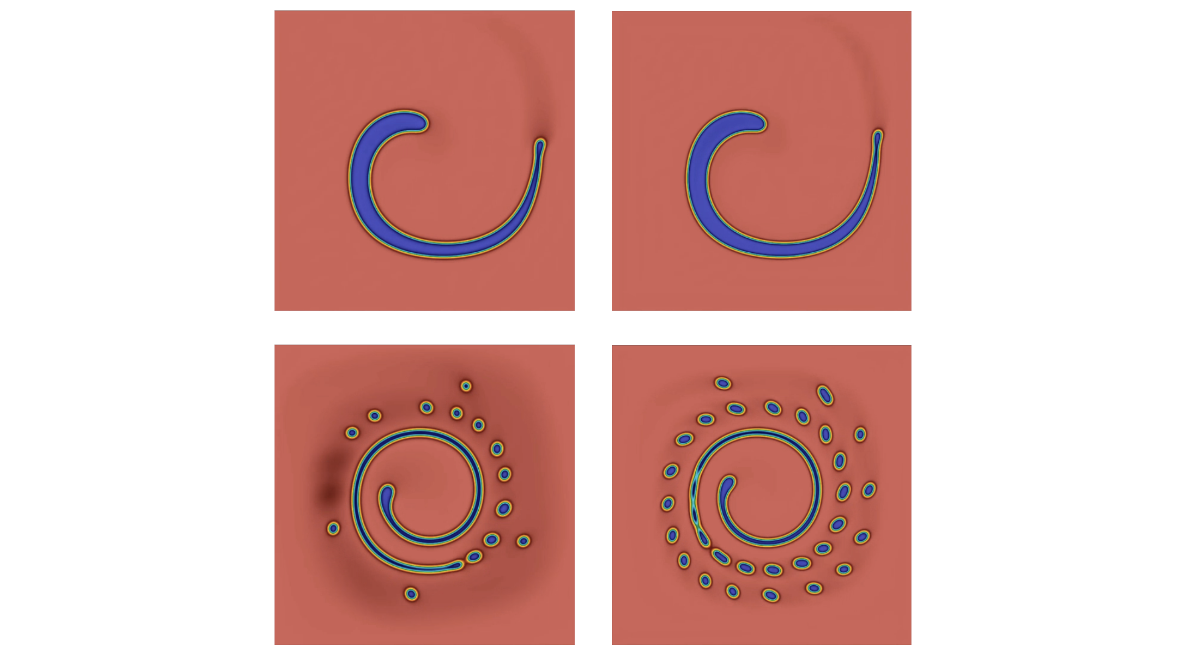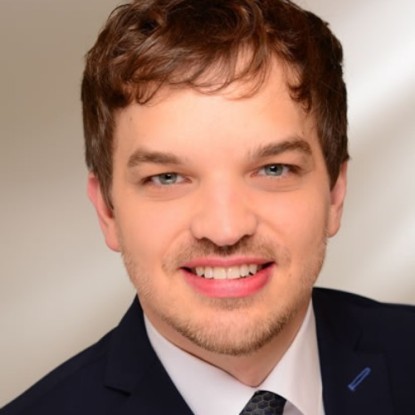
Prof. Dr.-Ing. Dominik Schillinger
Computational Mechanics
Contact
schillinger@mechanik.tu-...
work +49 6151 16-22741
Work
L5|01 546
Franziska-Braun-Straße 7
64287
Darmstadt
Links
-
![]()
Optimized topology and relative density distribution of an engine bracket (top). The de-homogenized structure shows regions with different relative densities (bottom). -
![]()
Architecture of a physics-informed neural network for predicting the effective stiffness tensor of isotropic elastic lattice structures. -
![]()
Isogeometric analysis with a trimmed shell formulation enables full interoperability with CAD, while achieving the same accuracy as standard FEA. -
![]()
Explicit dynamics of a wind turbine rotor blade with high-order accuracy using spectral elements based on Gauss-Lobatto-Lagrange functions and nodal Gauss-Lobatto quadrature. -
![]()
MicroCT-based calibration and validation of a micromechanics-based multiphase material model for oat stems. -
![]()
Framework for generating synthetic vascular structures based on global geometry and topology optimization, enabling multiple non-overlapping vascular trees in non-convex organs (e.g., liver). -
![]()
Concept of a multicompartment model for translating a discrete vascular structure into homogenized blood perfusion at different scales. -
![]()
The current patient-specific simulation paradigm is based on combining different, often incompatible technologies. We are developing new methods to overcome this fragmentation and seamlessly integrate image analysis and simulation techniques. -
![]()
Two-stage variational approach for segmenting 3D bone CT data that is robust to thin cartilage interfaces (US Patent 11257214). -
![]()
Multiscale failure simulation of a vertebral body. In the failure regions, coarse-scale elements are informed by local voxel-scale subproblems, whose results are upscaled via stress projection. -
![]()
Gas bubble rising through two immiscible liquid layers: As it ascends, the bubble deforms the liquid-liquid and gas-liquid interfaces, creating complex three-phase flows. -
![]()
Advective two-phase model (Cahn-Hilliard) of a swirling flow: Bound-violating Ginzburg-Landau potential (left) vs. bound-preserving Flory-Huggins potential (right), shown before breakup (top) and after breakup (bottom). -
![]()
Compressible Taylor-Green vortex (Re = 100): Transition to turbulent flow (vorticity contour lines), computed via the macro-element HDG method; dissipation rate of kinetic energy over time for different polynomial degrees and patch discretizations (diagram).
- Go to picture 1
- Go to picture 2
- Go to picture 3
- Go to picture 4
- Go to picture 5
- Go to picture 6
- Go to picture 7
- Go to picture 8
- Go to picture 9
- Go to picture 10
- Go to picture 11
- Go to picture 12
- Go to picture 13
Recommended external content
We have selected external content from YouTube for you and would like to show it to you right here. To do this, you must reveal it with one click. You can hide the external content at any time with another click.
I agree to external content from YouTube being shown to me. This may result in personal data being transmitted to third-party platforms. You can find more information in our Privacy Policy.
Multiphysics / physiology driven modeling and simulation
- Homogenization of inelastic material response (plasticity, micro-buckling)
- Physics-informed neural networks for modeling parametric microstructures (lattice structures)
- Multiscale and coupled multi-field modeling of biological growth processes (tumor growth, liver regeneration after resection)
- Homogenization of meso-/microscale flow through hierarchical vessel networks (hepatic / cerebral perfusion)
- Modeling of N-phase fluid mixtures (based on Navier-Stokes Cahn-Hilliard formulations)
- Variational segmentation models with phase-field methods (clinical CT/MRI scans, liver, bones)
Discretization methods in computational mechanics
- Finite element technology for higher-order accurate CutFEM
- Efficient isogeometric formulation for structural finite elements (for trimmed CAD freeform surfaces, locking-free mixed shell elements, accuracy-preserving diagionalization of the mass matrix, quadrature methods)
- Tensor-product spline methods for highly efficient RVE simulations
- Multiresolution methods based on multiscale FEM and model order reduction
- Hybrid Discontinuous Galerkin formulations for compressible flows (in variational multiscale format, entropy-stable, energy-preserving)
- Variational multiscale methods for subgrid-scale modeling
Optimization methods in computational mechanics
- Topology optimization across several hierarchical length scales (design of additively manufactured lattice structures)
- Computational generation of synthetic vasculature via mathematical optimizaiton (liver, brain, heart)
- Optimization of non-intersecting synthetic vascular trees in complex-shaped organs
Bachelor modules (BI, G/UI, CE, IWM)
- Engineering Mechanics I (Statics)
- Engineering Mechanics II (Deformable body mechanics)
- Engineering Mechanics III (Dynamics)
- Engineering Mechanics IV (Vibrations and tensor calculus)
- Project Course on Digitalization, AI and Data Science
Master modules (BI, CE, Mechanics)
- Fundamentals of the Finite Element Method (FEM I)
- Nonlinear Finite Element Methods in Structural Mechanics (FEM II)
- Stabilized Finite Element Methods for Computational Fluid Dynamics (FEM III)
- Computational Plasticity
- Model Order Reduction in Computational Solid Mechanics
- Seminar Computational Mechanics
Teaching partnership with Bethlehem University (West Bank)
- Introduction to Numerical Methods for Fluid Mechanics
- Finite Volume Methods for Turbulent Flows
| Since 10/2021 |
Full Professor (W3) of Computational Mechanics Institute for Mechanics Department of Civil and Environmental Engineering Technical University of Darmstadt, Germany |
| 01/2019 – 09/2021 |
Professor (W2) of Computational Mechanics and Scientific Computing in Mechanics Institute of Mechanics and Computational Mechanics Department of Civil Engineering and Geodetic Science Leibniz Universität Hannover, Germany |
| 11/2013 – 08/2019 |
Assistant Professor, then Associate Professor (tenured) Department of Civil, Environmental, and Geo- Engineering University of Minnesota, Twin Cities, USA |
| 03/2012 – 10/2013 |
Postdoctoral Fellow and Lecturer Institute for Computational Engineering and Sciences (ICES) Computational Mechanics Group (Prof. T.J.R. Hughes) The University of Texas at Austin, USA |
| 12/2008 – 02/2012 |
Dr.-Ing. (Ph.D.) in Computational Mechanics Chair for Computation in Engineering (Prof. E. Rank) Department of Civil, Geo and Environmental Engineering Technische Universität München, Germany |
| 04/2005 – 11/2008 |
Dipl.-Ing. (M.S.) in Modeling and Simulation Methods Department of Civil and Environmental Engineering University of Stuttgart, Germany |
| 04/2008 – 11/2008 |
Visiting Graduate Student (Diplomand) Institute of Structural Analysis and Anti-Seismic Research (Prof. M. Papadrakakis) National Technical University of Athens, Greece |
| 09/2005 – 07/2006 |
M.S. in Structural Engineering Department of Civil and Environmental Engineering (Prof. R.B. Malla) University of Connecticut, USA |
| 09/2004 – 02/2005 |
Schlaich Bergermann & Partner, Stuttgart Intern in structural engineering and design |
| 10/2001 – 04/2004 |
Undergraduate studies: Architecture and Civil Engineering University of Stuttgart, Germany |
| 2022 | Oberwolfach Research Fellow, Mathematical Research Institute of Oberwolfach (MFO) |
| 2020 | Finalist, FallingWalls Conference 2020 in the category “Engineering & Technology” |
| 2019 | Presidential Early Career Award for Scientists and Engineers (PECASE), White House |
| 2019 | EMI Leonardo da Vinci Award, American Society of Civil Engineers (ASCE) |
| 2017 |
ERC Starting Grant, European Research Council Title: “Multiscale imaging-through-analysis methods for autonomous patient-specific simulation workflows” |
| 2017 |
DFG Emmy Noether Award, German Research Foundation Title: “CAD-integrated simulation tools for higher-order aerodynamics and aeroelasticity” |
| 2017 | NSF CAREER Award, National Science Foundation |
| 2015 | ICE Zienkiewicz Medal and Prize, Institution of Civil Engineers |
| 2015 |
GAMM Richard von Mises Prize, International Association of Applied Mathematics and Mechanics (GAMM) |
| 2012 – 2013 | DFG Research Fellowship, German Research Foundation |
| 2012 | DAAD Postdoctoral Fellowship, German Academic Exchance Service (declined) |
| 2012 | IACM John Argyris Award, International Association for Computational Mechanics |
| 2005 – 2006 | Baden-Württemberg Scholarship |
| 2005 | Admission to the German Academic Scholarship Foundation |
| 2004 | Tuition waiver for the diploma program at the University of Stuttgart (top 3%) |

Error on loading data
An error has occured when loading publications data from TUbiblio. Please try again later.
-
{{ year }}
-
; {{ creator.name.family }}, {{ creator.name.given }}{{ publication.title }}.
; {{ editor.name.family }}, {{ editor.name.given }} (eds.); ; {{ creator }} (Corporate Creator) ({{ publication.date.toString().substring(0,4) }}):
In: {{ publication.series }}, {{ publication.volume }}, In: {{ publication.book_title }}, In: {{ publication.publication }}, {{ publication.journal_volume}} ({{ publication.number }}), ppp. {{ publication.pagerange }}, {{ publication.place_of_pub }}, {{ publication.publisher }}, {{ publication.institution }}, {{ publication.event_title }}, {{ publication.event_location }}, {{ publication.event_dates }}, ISSN {{ publication.issn }}, e-ISSN {{ publication.eissn }}, ISBN {{ publication.isbn }}, DOI: {{ publication.doi.toString().replace('http://','').replace('https://','').replace('dx.doi.org/','').replace('doi.org/','').replace('doi.org','').replace("DOI: ", "").replace("doi:", "") }}, Official URL, {{ labels[publication.type]?labels[publication.type]:publication.type }}, {{ labels[publication.pub_sequence] }}, {{ labels[publication.doc_status] }} - […]
-
Number of items in this list: >{{ publicationsList.length }}
Only the {{publicationsList.length}} latest publications are displayed here.

